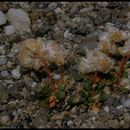en
names in breadcrumbs


Calyptridium umbellatum, synonym Cistanthe umbellata, is a species of flowering plant in the montia family known by the common name Mount Hood pussypaws or — especially outside the Pacific Northwest — simply pussy-paws.[5]
Calyptridium umbellatum is native to western North America from British Columbia to California to Colorado, where it grows in a number of habitat types, including areas inhospitable to many other plant types, such as those with alpine climates.
A small subgroup of C. umbellatum are located in the Zayante Sandhills, a biological island in the Santa Cruz Mountains.[6] These individuals reside on a singular hill in the entirety of the sandhills, and their frail petals and loose seeds allow for easy wind dispersal.
It is a perennial herb forming generally two or more basal rosettes of thick, spoon-shaped leaves each a few centimeters long. The inflorescence arises from the rosette, a dense, spherical umbel of rounded sepals and four small petals.
C. umbellatum usually has only one inflorescence per basal rosette; the related C. monospermum generally has more than one.[7]
Calyptridium umbellatum, synonym Cistanthe umbellata, is a species of flowering plant in the montia family known by the common name Mount Hood pussypaws or — especially outside the Pacific Northwest — simply pussy-paws.